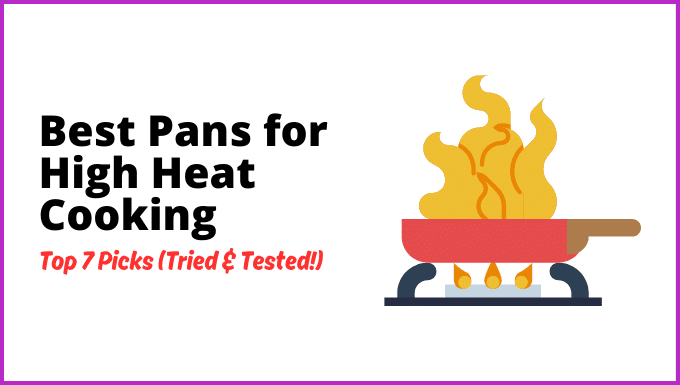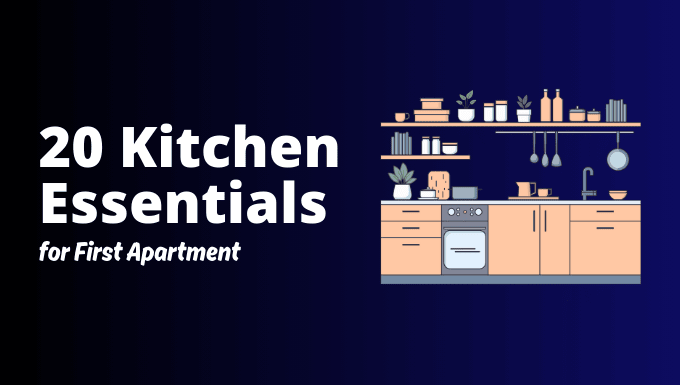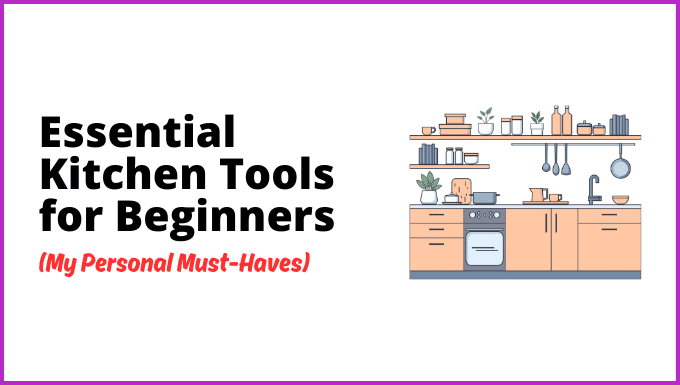I still remember the first time I tried to sear a steak in a cheap non-stick pan. Instead of that beautiful, crispy crust, I ended up with a sad, grayish piece of meat—and a pan that was completely ruined from the high heat. That’s when I realized not all pans are built for high-heat cooking.
If you love cooking techniques like searing, stir-frying, or blackening, you need a pan that can handle extreme temperatures without warping, losing its non-stick coating, or releasing harmful chemicals. After years of trial and error (and a few ruined meals), I’ve found the best pans for high heat cooking that actually deliver restaurant-quality results.
In this guide, I’ll share my top 7 picks based on personal experience, expert recommendations, and real-world durability. Whether you’re a beginner or an experienced home cook, this list will help you choose the perfect pan for high-heat cooking.
👉 If you’re also looking for other essential cookware, check out my guide on must-have kitchen tools for home chefs!
Now, let’s dive into what makes a pan truly heat-resistant and which ones are worth your investment. 🔥

What to Look for in a High-Heat Pan?
When I first started cooking with high heat, I made the mistake of using the wrong type of pan. I remember trying to sear a steak in a non-stick pan, only to end up with a burnt surface and a pan that was ruined. That’s when I realized—not all pans can handle high temperatures! If you love searing, stir-frying, or any high-heat cooking, choosing the best pans for high heat cooking is a game-changer. Here’s what you need to know:
1. Heat Resistance: Can It Handle the Heat?
Not all pans are built to withstand extreme temperatures. A good high-heat pan should be able to handle at least 500°F (260°C) or more without warping or breaking down. Stainless steel, cast iron, and carbon steel are excellent choices because they maintain their structure under intense heat. Avoid traditional non-stick pans—they tend to degrade at temperatures above 450°F.
2. Material Matters: Which One Is Best?
The material of your pan plays a huge role in performance. Here’s a quick breakdown of the best options:
- Cast Iron: Amazing heat retention, perfect for searing and frying. But it needs seasoning and proper care.
- Carbon Steel: Lighter than cast iron, yet still holds heat well. A favorite among professional chefs.
- Stainless Steel: Durable, non-reactive, and great for browning. Ideal for high-heat cooking and deglazing sauces.
- Hard-Anodized Aluminum: Stronger than regular aluminum and resistant to scratches. Heats evenly but isn’t as durable as stainless steel.
If you’re looking for a deeper dive into the pros and cons of these materials, check out my guide on best kitchen tools for home chefs—it covers cookware essentials in more detail.
3. Durability and Maintenance: Will It Last?
A high-quality pan should last for years, if not decades. Cast iron and carbon steel get better with time, forming a natural non-stick surface. Stainless steel requires less maintenance but needs oil for a good sear. If you prefer low-maintenance options, enameled cast iron is a great alternative—it doesn’t require seasoning like traditional cast iron.
4. Handle and Weight: Can You Control It?
Heavy-duty pans are great for heat retention, but if they’re too heavy, they can be hard to maneuver. I personally love my carbon steel pan because it’s sturdy but easier to lift than my cast iron skillet. Also, make sure the handle is heat-resistant and provides a comfortable grip—especially if you’re frequently tossing food while stir-frying.
5. Compatibility: Does It Work with Your Cooktop?
If you have an induction cooktop, ensure your pan is induction-compatible (like cast iron or stainless steel). Some aluminum pans may require a magnetic base to work properly.
Final Thoughts
Finding the best pans for high heat cooking comes down to heat resistance, material, durability, and ease of use. If you love searing steaks, a cast iron or carbon steel pan is a must-have. If you want versatility, stainless steel is an excellent choice. Whatever you pick, taking care of your pan will ensure it lasts for years!
For more cookware recommendations, you might find my best cookware sets for every kitchen guide helpful—it covers sets that include some of these high-heat options. Happy cooking! 🍳🔥
The 7 Best Pans for High Heat Cooking
If you love searing a perfect steak, stir-frying crispy vegetables, or achieving that golden-brown crust on chicken, you need the right cookware. Not all pans can handle high heat without warping, losing their non-stick coating, or even releasing harmful fumes. Trust me, I’ve ruined enough cheap pans to know what works and what doesn’t!
After years of trial and error, I’ve found the best pans for high heat cooking that can truly take the heat. Let’s dive in!
1. Cast Iron Skillet – The Classic Choice
I can’t talk about high-heat cooking without mentioning cast iron. This pan is my go-to for searing steaks because it retains heat incredibly well and distributes it evenly. Once it’s hot, it stays hot, making it perfect for achieving a deep, flavorful crust on meats.
- Pros: Withstands extremely high heat, naturally non-stick when seasoned properly, lasts a lifetime.
- Cons: Requires seasoning and regular maintenance to prevent rust.
- Best for: Searing, frying, baking, and even oven use.
If you’re new to cast iron, learning how to care for it is crucial. Check out my guide on how to season a cast iron pan to keep it in top shape!
2. Carbon Steel Pan – Lightweight Yet Durable
Carbon steel is like cast iron’s lighter, more responsive cousin. I started using one when I needed something easier to maneuver but still capable of high heat. It heats up faster and becomes naturally non-stick over time.
- Pros: Lightweight, heats up quickly, gets better with use.
- Cons: Needs seasoning and regular care.
- Best for: Stir-frying, searing, and high-heat sautéing.
3. Stainless Steel Pan – Versatile and Reliable
If you want a high heat-resistant pan that doesn’t require seasoning, stainless steel is a great option. I use mine for everything from browning chicken to deglazing for flavorful sauces. It doesn’t react with acidic foods like tomatoes or vinegar, which is a big plus!
- Pros: Non-reactive, durable, oven-safe.
- Cons: Not naturally non-stick, so you’ll need oil.
- Best for: Searing, browning, and making pan sauces.
If you love making sauces after cooking meats, this is the pan for you!
4. Hard-Anodized Aluminum Pan – Scratch & Warp Resistant
I was skeptical about aluminum pans for high-heat cooking until I tried a hard-anodized version. Unlike regular aluminum, these are reinforced to handle heat better and resist scratches. I love using mine for quick high-heat frying since it heats up fast and evenly.
- Pros: Scratch-resistant, warp-resistant, great heat distribution.
- Cons: Not as long-lasting as cast iron or stainless steel.
- Best for: High-heat frying, sautéing, and everyday cooking.
5. Blue Carbon Steel Pan – Pro Chef’s Favorite
If you’ve ever watched professional chefs cook, you’ve likely seen them use a blue carbon steel pan. It heats up incredibly fast and offers a perfect sear, which is why I got one for my own kitchen. Over time, it develops a beautiful patina that enhances its non-stick properties.
- Pros: Super fast heating, naturally non-stick over time.
- Cons: Requires seasoning and maintenance.
- Best for: Searing, frying, and wok-style cooking.
6. Copper Core Stainless Steel Pan – Luxury Performance
I’ll admit, this one is a bit of a splurge, but if you want the best pan for high heat cooking with ultra-precise heat control, a copper core stainless steel pan is worth it. I use mine when cooking delicate foods that still require high heat, like scallops.
- Pros: Fast, even heating, precise temperature control.
- Cons: Expensive, requires polishing to maintain its look.
- Best for: Searing, high-heat sautéing, and delicate proteins.
7. Enameled Cast Iron – Best for High Heat & Acidic Foods
Regular cast iron is fantastic, but if you’re cooking acidic foods like tomato-based dishes, enameled cast iron is even better. I love using my enameled Dutch oven for high-heat cooking and slow braising.
- Pros: No seasoning required, doesn’t react with acidic foods.
- Cons: Heavier than regular cast iron, more expensive.
- Best for: Searing, braising, and oven use.
If you’re into one-pot meals, this is a fantastic investment. You can check out my list of best kitchen tools for home chefs for more must-have cookware recommendations!
Each of these pans brings something unique to the table, but they all have one thing in common: they can handle the heat! Choosing the best pan for high heat cooking depends on what you cook most often. If I had to pick just one, I’d go with cast iron for versatility and durability.
What’s your favorite pan for high-heat cooking? Let me know in the comments! 😊
How to Care for High-Heat Pans to Make Them Last
Over the years, I’ve learned that even the best pans for high heat cooking won’t last if they’re not properly cared for. I made a few mistakes early on—like overheating non-stick pans and using the wrong cleaning methods—but now, I know exactly what works. Here’s how you can keep your high-heat cookware in top shape.
1. Season Your Cast Iron and Carbon Steel Pans
If you own a cast iron or carbon steel pan, seasoning is a must. The first time I used my cast iron skillet without seasoning, everything stuck to it, and I thought I had ruined it. But once I learned the right way to season it, cooking became a breeze.
How to season your pan:
- Wash the pan with warm water and a little soap (just this once).
- Dry it completely using a towel.
- Rub a thin layer of oil (flaxseed, vegetable, or canola oil) all over the surface.
- Bake it upside down in the oven at 450°F (232°C) for about an hour.
- Let it cool before storing.
Over time, your pan will develop a natural, non-stick surface. If you’re new to seasoning, check out this guide on how to season a cast iron pan for step-by-step instructions.
2. Avoid Drastic Temperature Changes
One mistake I made early on was rinsing a hot pan under cold water—bad idea! This can cause thermal shock, leading to warping or even cracks in certain materials like cast iron and carbon steel.
Instead, let your pan cool naturally before washing it. This simple step can significantly extend the lifespan of even the best pans for high heat cooking.
3. Use the Right Cleaning Methods
Each pan material has its own cleaning method. Here’s what I’ve learned:
- Cast Iron & Carbon Steel: Use warm water and a scrub brush. Avoid soap (except occasionally) and never soak them. If food sticks, use coarse salt to scrub it off.
- Stainless Steel: A little dish soap and warm water work well. For stubborn stains, a baking soda and vinegar mix does wonders.
- Hard-Anodized Aluminum & Copper Core: Stick to mild soap and soft sponges. Abrasive cleaners can damage the surface.
For more cleaning tips, you might find this kitchen tools maintenance guide helpful.
4. Store Your Pans Properly
Stacking pans carelessly can cause scratches and damage over time. I used to just toss my pans into the cabinet, but now I use these simple storage tricks:
- Use pan protectors (or a clean dish towel) between stacked pans.
- Hang your pans if you have the space—it prevents scratches and looks great in a kitchen.
- Keep lids separately to avoid unnecessary weight on your cookware.
5. Choose the Right Cooking Utensils
Using the wrong utensils can ruin your pan’s surface. I learned this the hard way when I scratched my favorite stainless steel pan with a metal spatula. Now, I follow these guidelines:
- For stainless steel, cast iron, and carbon steel: Metal utensils are fine.
- For non-stick and hard-anodized aluminum: Stick to wood, silicone, or plastic to prevent scratches.
Final Thoughts
Taking care of your high-heat cookware doesn’t have to be complicated. A little effort in cleaning, seasoning, and proper storage goes a long way in making sure your pans last for years. Trust me, once you get into these habits, you’ll see the difference in your cooking experience!
Want to learn more about choosing the right cookware? Check out this list of essential kitchen tools for home chefs to upgrade your cooking game.
Final Thoughts: Which Pan is Best for You?
After years of trial and error in the kitchen, I’ve realized that choosing the best pans for high heat cooking depends on what and how you cook. If you love a perfect steak with a crispy, caramelized crust, a cast iron skillet is unbeatable. It holds heat like a champ and only gets better with time. Just remember to season it properly to keep it non-stick and rust-free.
If you prefer something lighter but still want that incredible sear, carbon steel is a fantastic alternative. It heats up quickly, is easier to maneuver, and, with proper care, can last a lifetime. I use mine for everything from stir-frying veggies to making restaurant-quality smash burgers.
For those who don’t want to worry about seasoning or extra maintenance, stainless steel pans are a solid pick. They can handle super high temperatures without warping or reacting with acidic foods. I love using mine for deglazing after searing meat—it makes the most delicious pan sauces!
If convenience is a priority, hard-anodized aluminum pans are worth considering. They distribute heat well, resist scratching, and work great for high-heat sautéing. I’ve found them especially useful when I need something durable but low-maintenance.
And let’s not forget enameled cast iron, which is perfect if you love high-heat cooking but don’t want to deal with seasoning. I use mine for everything from oven-baked dishes to stovetop frying—it’s a true workhorse in the kitchen.
Ultimately, the best pan for you depends on your cooking style and preferences. If you’re just getting started, a stainless steel pan is a great all-around choice. But if you’re serious about high-heat cooking, investing in a cast iron or carbon steel pan will make a world of difference.
👉 Looking for a step-by-step guide on keeping your pans in top shape? Check out my pan care and maintenance guide for expert tips!

